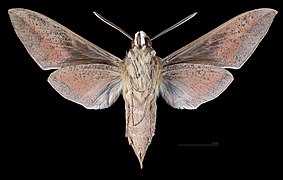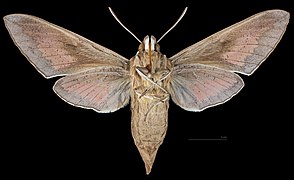Hyles hippophaes
| Seathorn hawk-moth | |
|---|---|
 | |
| Scientific classification | |
| Domain: | Eukaryota |
| Kingdom: | Animalia |
| Phylum: | Arthropoda |
| Class: | Insecta |
| Order: | Lepidoptera |
| Family: | Sphingidae |
| Genus: | Hyles |
| Species: | H. hippophaes |
| Binomial name | |
| Hyles hippophaes | |
| Synonyms | |
| |
Hyles hippophaes, the seathorn hawk-moth, is a species of moth in the family Sphingidae. The species was first described by Eugenius Johann Christoph Esper in 1789.
Distribution[edit]
It is found in Afghanistan, Armenia, Azerbaijan, China, France, Georgia, Germany, Greece, Iran, Iraq, Kazakhstan, Kyrgyzstan, Mongolia, Pakistan, Romania, Serbia and Montenegro, Spain, Switzerland, Syria, Tajikistan, Turkey, Turkmenistan, and Uzbekistan.
Description[edit]
The wingspan is 65–80 mm. Subspecies H. h. bienerti is paler and browner than related subspecies. A pale, oblique median line is noticeable on the underside of the forewing. The hindwing patches are more orange than red.
- Hyles hippophaes ♂
- Hyles hippophaes ♂ △
- Hyles hippophaes ♀
- Hyles hippophaes ♀ △
Biology[edit]
Larvae of subspecies H. h. bienerti have been recorded on Elaeagnus angustifolia and Hippophae rhamnoides in China and Tajikistan.
Subspecies[edit]
- Hyles hippophaes hippophaes
- Hyles hippophaes bienerti (Staudinger, 1874) (from Turkey, the Caucasus and southern Russia, east through Iran, Turkmenistan, Uzbekistan, Tajikistan, Afghanistan to Kashmir and north-western India, and north-east through Kyrgyzstan and eastern Kazakhstan to northern China, Mongolia, Lake Baikal and Tuva in Russia)[3]
- Hyles hippophaes miatleuskii Eitschberger & Saldaitis, 2000 (Kazakhstan)
References[edit]
- ^ World Conservation Monitoring Centre (1996). "Hyles hippophaes". IUCN Red List of Threatened Species. 1996: e.T10542A3198676. doi:10.2305/IUCN.UK.1996.RLTS.T10542A3198676.en. Retrieved 15 November 2021.
- ^ "CATE Creating a Taxonomic eScience - Sphingidae". Cate-sphingidae.org. Archived from the original on 2012-10-16. Retrieved 2011-10-25.
- ^ Pittaway, A. R.; Kitching, I. J. (2018). "Hyles hippophaes bienerti (Staudinger, 1874) -- Seabuckthorn hawkmoth". Sphingidae of the Eastern Palaearctic. Retrieved December 15, 2018.
Sources[edit]
External links[edit]


 French
French Deutsch
Deutsch



